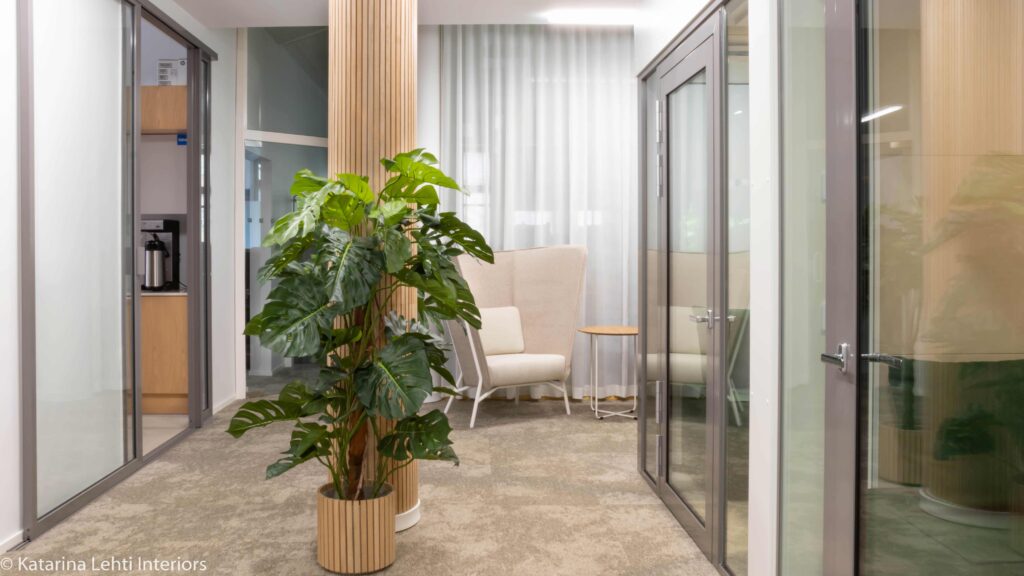Textile tiles and wall-to-wall carpets are popular flooring solutions for office spaces, but which is the better choice? The decision depends on several factors such as the purpose of the space, budget, and desired appearance. Textile tiles offer flexibility, easy replacement, and versatile design possibilities. Wall-to-wall carpets, on the other hand, create a unified surface, provide better sound insulation, and often create a more luxurious atmosphere. There is no definitive answer – both options have their place in office interior design depending on the needs and purpose of the space.
Office Flooring Materials – Textile Tiles or Wall-to-Wall Carpets?
The choice of office flooring material significantly impacts the usability, atmosphere, and acoustics of the space. When considering office carpet options, the two most common alternatives are textile tiles and wall-to-wall carpets. Both materials improve room acoustics, create a warm atmosphere, and enhance comfort.
Textile tiles are typically 50 x 50 cm individual pieces that are installed side by side to form a unified surface. They are often attached with adhesive glues, allowing for easy removal and replacement. Wall-to-wall carpets, on the other hand, are installed as a continuous surface throughout the entire space, creating a seamless and unified appearance.
Both textile tiles and wall-to-wall carpets are primarily made from synthetic fibers, such as polyamide, but natural fibers and recycled materials are increasingly being utilized. Both options have the M1 indoor air classification, ensuring their safety for indoor use.
What Are the Benefits of Textile Tiles in Office Spaces?
Textile tiles offer significant advantages in office environments, especially in spaces where flexibility and adaptability are important. One of the greatest benefits is the ability to replace individual damaged tiles without having to replace the entire floor surface.
Textile tiles enable creative flooring solutions. By combining different colors, patterns, and textures, unique designs can be created, highlighting pathways or delineating different areas. This is particularly useful in open-plan offices where visual elements can clarify spatial divisions.
Installation is often faster and easier compared to wall-to-wall carpets, reducing installation costs and minimizing operational disruptions. The transportation and storage of textile tiles is also easier due to their compact size.
Additionally, many modern textile tiles are made from recycled materials and are fully recyclable at the end of their life cycle. For example, tiles with self-adhesive LiftBAC backing are environmentally friendly options that can be installed on many different floor surfaces without damaging them.
When Are Wall-to-Wall Carpets a Better Solution for Offices?
Wall-to-wall carpets are an excellent choice when you want to create a unified and seamless look in an office space. They provide a visually calm and harmonious effect that is particularly suitable for prestigious areas such as meeting rooms and executive offices.
Sound insulation is one of the most significant advantages of wall-to-wall carpets. A seamless surface dampens sound more effectively than textile tiles, making them ideal for spaces where acoustics are especially important. This reduces echoing and footstep noise, thus improving working conditions and concentration.
Wall-to-wall carpets often create a more luxurious atmosphere and a softer feel underfoot. This increases comfort and the pleasantness of the space. Large, open areas particularly benefit from wall-to-wall carpets as they help create a unified look across the entire area without the interruption of tile seams.
The newest wall-to-wall carpets are also increasingly environmentally friendly and contain recycled materials. Their manufacturing increasingly employs water-saving techniques and processes that put less strain on the environment.
How Do Durability and Maintainability Differ Between These Materials?
In terms of durability and maintainability, textile tiles and wall-to-wall carpets differ significantly. Textile tiles offer a clear advantage in maintainability, as replacing damaged sections is easy and cost-effective. If, for example, coffee spills or another stain occurs, only the damaged tile needs to be replaced.
Cleaning wall-to-wall carpets typically requires professional equipment and expertise, especially for deeper cleaning. With textile tiles, removing individual tiles for thorough cleaning is easier, which can extend the floor’s lifespan.
Wear shows in both materials but in different ways. In wall-to-wall carpets, wear often appears as worn pathways, which are challenging to repair. With textile tiles, worn areas can be replaced with new tiles, keeping the overall appearance of the floor tidy for longer.
How to Choose the Right Flooring Solution for Office Needs?
When selecting an office flooring solution, several factors must be considered. The purpose of the space is primary: high-traffic areas benefit from textile tiles, while prestigious spaces may require the luxury that wall-to-wall carpets provide. The budget affects both short and long-term decisions – both initial investment and lifecycle costs must be taken into account.
The adaptability needs of the space should be carefully assessed. If the office layout changes frequently, textile tiles offer flexibility. If the space remains unchanged for long periods, wall-to-wall carpet might be a better choice.
Brand image and visual identity also guide the selection. Textile tiles can create diverse patterns and color schemes, while wall-to-wall carpets offer a unified, calm surface. VMC Project also offers the possibility of printed carpets, which can incorporate a designer’s own design or the company’s brand identity.
At VMC Project, we help you find the right flooring solution for your office needs. Our experts work closely with designers, architects, and end-users to ensure the best possible outcome. Contact us to learn more about your options! You can also explore our services in more detail on our website.


